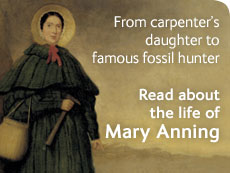- Home
- > Nature online
- > Life
- > Dinosaurs and other extinct creatures
- > Non-dinosaur reptiles
- > Aquatic reptiles
Primary navigation
- Life
- Mammals
- Birds
- Reptiles, amphibians and fishes
- Insects and spiders
- Other invertebrates
- Dinosaurs and other extinct creatures
- Dino directory
- The most complete Stegosaurus in the world
- Prehistoric world in pictures
- News
- Archaeopteryx - snapshot of evolution in action
- Mass extinctions
- Non-dinosaur reptiles
- Ida - the clue to primate evolution?
- Baryonyx (video)
- Augmented reality Coelophysis
- Scelidosaurus (video)
- World's smallest mini mammoth (video)
- Dino-birds
- Big teeth for a tiny dinosaur
- T.rex: the killer question quiz
- Virtual specimens
- Ostrich dinosaurs
- The search for DNA in amber
- Plants and fungi
- Human evolution
Aquatic reptiles
Mosasaurs, ichthyosaurs and plesiosaurs were all aquatic reptiles living millions of years ago. Learn about some of the animals in this group below.
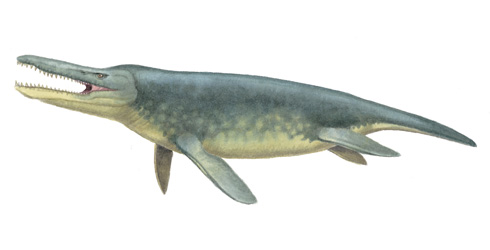
Name: Kronosaurus
Age(s): 121-112 million years ago
Period: Early Cretaceous (Aptian-Albian)
Size: Less than 12.8 metres
Location(s) found: Australia (Queensland), Colombia (Boyaca Region)
Notes: Kronosaurus was a pliosaur (a short-necked plesiosaur). It is named after Kronos, of greek myth, who devoured his children.
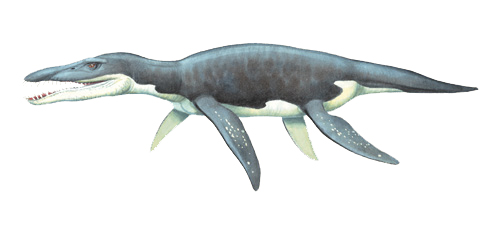
Name: Liopleurodon
Age(s): 165-150 million years ago
Period: Mid Jurassic (Bathonian-Tithonian)
Size: 15 metres
Location(s) found: UK (Cambridgeshire, Bedfordshire), France, Russia, Chile
Notes: Liopleurodon was a large pliosaur (a short-necked plesiosaur). It had a large head, up to 3 metres long, and fed on ichthyosaurs and plesiosaurs. Evidence for this comes from bite marks found on paddle bones that were probably made by a Liopleurodon -type animal. Estimates that it was 25 metres long are probably inaccurate.

Name: Rhomaleosaurus
Age(s): 205-180 million years ago
Period: Early Jurassic (Hettangian-Toarcian)
Size: 5-7 metres
Location(s) found: UK (Yorkshire, Leicestershire), Germany (Holzmaden)
Notes: Rhomaleosaurus was a pliosaur (a short-necked plesiosaur) and was a strong swimmer with large front paddles. One study showed that it had an underwater sense of ‘smell’. Its internal nostrils inside the roof of its mouth, had grooves that channelled water to the nostril area where the water could be ‘smelled’. Later studies have shown this to be a more widespread feature amongst plesiosaurs.

Name: Macroplata
Age(s): 205-202 million years ago
Period: Early Jurassic (Hettangian)
Size: Up to 5 metres
Location(s) found: UK (Warwickshire, Yorkshire)
Notes: Macroplata was a pliosaur (a short-necked plesiosaur). It had needle-like teeth and a relatively long neck. Its large skull with a narrow snout was 60-70 centimetres long. The shape of its shoulder bones indicated that it had a powerful forward swimming stroke.
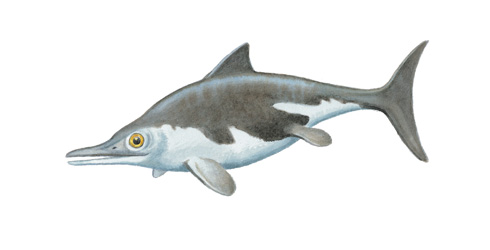
Name: Ophthalmosaurus
Age(s): 165-150 million years ago
Period: Late Jurassic (Bathonian-Tithonian)
Size: Up to 6 metres
Location(s) found: UK, USA (Wyoming), Argentina (Neuquen), Russia (Undoria), Norway
Notes: Ophthalmosaurus had large eyes, around 10 centimetres in diameter, suggesting that it hunted its prey, probably fish and squid, in low light levels. Studies calculate that this ichthyosaur could hold its breath for 20 minutes or more. It had a dolphin-like body shape and large front paddles. Ophthalmosaurus was also viviparous (gave birth to live young).

Name: Shonisaurus
Age(s): 221-210 million years ago
Period: Late Triassic (Norian)
Size: 15 metres (Shonisaurus popularis), 21 metres (Shonisaurus sikanniensis)
Location(s) found: USA (Nevada), Canada (British Columbia)
Notes: Shonisaurus was the largest recorded ichthyosaur. S. popularis is estimated to have weighed 40 tons. Its skull was 3 metres long and it had a whale-like body with long paddles. Its name means ’lizard from the Shoshone Mountains‘. At a site in Nevada, 37 individuals were found preserved. They may have been beached on a mudflat, in such a condition as whales are sometimes found in today.
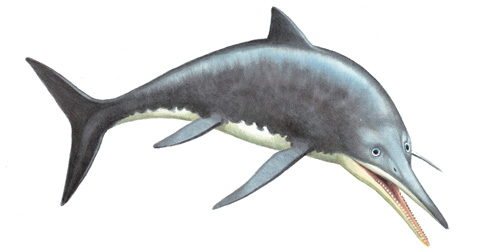
Name: Temnodontosaurus
Period: Early Jurassic
Size: 9 metres
Location(s) found: UK (Dorset), Germany (Wurttemberg)
Notes: Temnodontosaurus ate squid and ammonites (extinct cephalopods). This ichthyosaur had some of the largest eyes measured so far in the animal kingdom (about 20 centimetres in diameter). It was viviparous (gave birth to live young), as indicated by some beautifully preserved fossils showing both adult and baby individuals. It had large, conical teeth and a fish-like caudal fin.
Related information
- Fossils
- Fossil Marine Reptiles gallery
- World's first ichthyosaur goes home after 200 years news, Aug 2011
External links
Toolbox
- Contact and enquiries
- Accessibility
- Site map
- Website terms of use
- © The Trustees of the Natural History Museum, London
- Information about cookies
- Mobile
